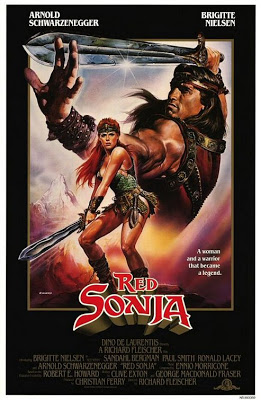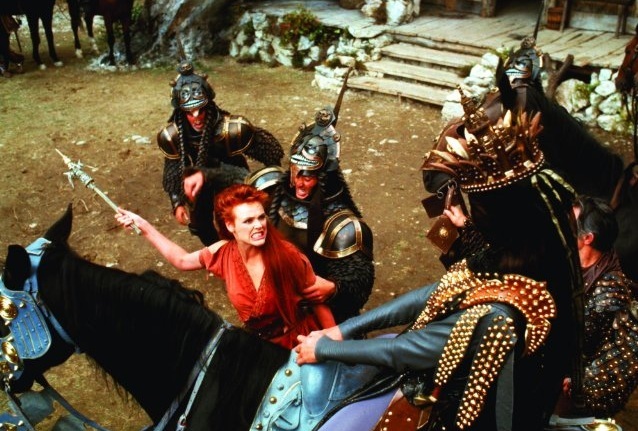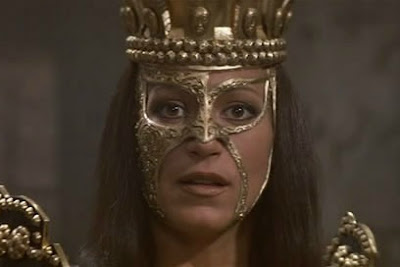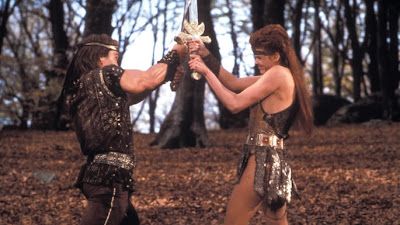
This guest post by Liz LaBrocca appears as part of our theme week on Dystopias.
Terminator Genisys, the fifth installment in the Terminator franchise, reminds you how much you loved Terminator and Terminator 2: Judgement Day while simultaneously destroying everything that made the first two movies exciting, scary, and romantic. In particular, Sarah Connor, damsel in distress turned warrior, has been reduced to a quippy, bland plot device instead of the powerful ready-made warrior she could have been.
The greatness of Sarah Connor’s character (as played by Linda Hamilton) between T1 and T2 was her transition from a frightened young girl to a self-made soldier. Within the first movie alone, we see her transformation from a terrified waitress in need of Kyle Reese’s (Michael Biehn) protection to a woman who is learning that she’s more capable than she ever believed. As their brief love is budding, she bandages one of his wounds. He compliments her field dressing and she, knowing now what her future holds, sadly replies, “Thanks, it’s my first.” By the end of the movie she is trying her best to save his life, commanding him (“Move, Soldier!”) to get up and keep fighting with her. In the end, he sacrifices himself in his best effort to save her and she is left to carry his child, future resistance leader John Connor, and the heavy burden of preparing both of them for the coming nuclear apocalypse.

In T2, we jump ten years into the future where John Connor is a wayward teenager, living in a foster home while Sarah is institutionalized for paranoid delusions. She has spent the past decade living with various men in order to learn as much as she can about arming and defending herself. We’re introduced to her in the institution as she does chin-ups on her overturned bed frame to keep herself physically primed for the coming war. While John and the reprogrammed Terminator (Arnold Schwarzenegger) are coming to rescue Sarah from the T-1000 in the psych ward, she has already mostly broken out on her own. Hamilton’s T2 Sarah Connor was muscular, sweaty, and terse. She looked like someone who had spent a decade physically and emotionally preparing for a nuclear war. At the same time, it was clear that she deeply cared about her son and was struggling with how to be a mother in a world that only she knows is destined to be destroyed. She reflects that the Terminator, ironically, ends up being the best father figure John has known in the absence of Reese.

We were given so little of Sarah in the preview of Genisys, I was holding onto a little hope that she wouldn’t be totally stripped of her mettle as a result of losing her original character arc. In Terminator Genisys, Sarah (played by Emilia Clarke of Game of Thrones) has been raised by the Terminator (Arnold Schwarzenegger) since she was 9. He was sent back in time to protect her from a T-1000 that had been sent to kill her and her family. There are plenty of reviews that discuss the convoluted time problems and horrifyingly dull plot in Genisys, so I’ll spare you.
Sarah meets Reese (Jai Courtney) knowing that she will need to have sex with this man, regardless of how she feels, to save the human race. It’s an awkward problem that’s dealt with in Schwarzenegger one-liners about mating and a weak attempt at a narrative theme of free will versus destiny. Her dialogue is full of jokes and one-liners instead of the brusque, efficient speech patterns you’d associate with a woman who spent her formative years with a Terminator who has still, several decades later, not mastered the art of smiling despite his detailed files on human anatomy. What was once a heated, passionate romance in the midst of a life-altering conflict, is boiled down to a silly comedy subplot: how does Sarah tell Reese that he’s the father of his best friend and mentor? This problem is further compounded by the painful lack of chemistry between Clarke and Courtney. The one upside to this forced romance subplot is that Sarah’s need to be impregnated is nullified by the vilification of John Connor. The film ends with her ability to choose to be with Reese instead of needing to be with Reese. But perhaps a more interesting, and more feminist, ending would be her choosing to not be with Reese at all.

The problem of Sarah’s character also lies within the casting of Emilia Clarke. While Courtney is a big, hulking man, who looks like he’s been slamming protein shakes in his post-apocalyptic future wasteland home (in T1 children hunt rats for food), Sarah looks as though she’s barely run a mile in preparation for the impending war she’s about to fight. Sure, they arm her with a bunch of guns and she looks really cool. She even looks a bit like Linda Hamilton. But she doesn’t look strong the way Linda Hamilton looked strong in T2. She doesn’t look like she has spent her youth and early adulthood physically training to be a fighter.
What it boils down to is that Courtney was cast in the traditional image of protector, even though the intention of the storyline was to subvert that role and have Sarah be the savior. It didn’t matter that he looks absolutely nothing like Michael Biehn because his perfectly chiseled abs looked great during naked time travel. He can even be hit by a car on the freeway with barely any consequences. In contrast, Biehn’s Reese was cut but lean; he was dirty and on edge. He looked like someone who came from a nuclear wasteland where meals were scarce and the threat of death was constant. He could be injured and killed. Had both actors been cast more appropriately in Genisys, she and Reese could have at least stood side by side as a team of equals ready to fight Cyberdyne via Genisys.

There was potential for this character to be extremely interesting. She could have been a darker, off-beat female heroine. She could have been the result of a human who spent her life training to be a warrior by an emotionless robot. But because the studio chose to play it safe and go for mass appeal and a PG-13 rating, we’re left with a watered-down version of the original character. Sarah Connor’s character was exactly what I was afraid she would end up being: a shallow plot device who is only there to make sure we know what’s happening in the new present and to fret over her impending romance with Reese. She is a shadow of an action hero, saying her lines but never embodying the role.
Liz LaBrocca is a freelance writer and editor living in Northampton, Massachusetts. She’s Co-Editor in Chief of The Soapbox, an online platform for amplifying the voices of female-identifying creators. You can follow her writing, cooking, and very important opinions on Twitter and Instagram.













